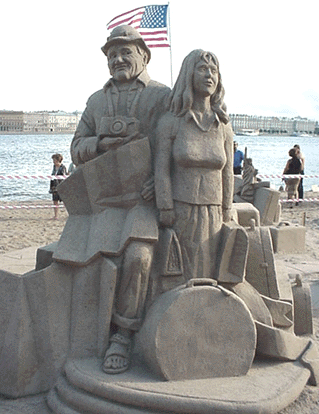Cities and Towns Along the Way
The Trans-Siberian
trains stop several times a day, for periods ranging from just a few
moments to almost half an hour. Even the longest stops, however,
allow for little more than a quick expedition from the station to
make some necessary purchases. It is possible, however, to arrange a
stopover in many of the major destinations along the route, and what
follows is a brief listing of some of the most popular sites.
Yaroslavl
One of
Russia's oldest cities, Yaroslavl was founded by Yaroslav the Wise
of Kievan Rus' in 1010. Over the next several centuries the city
prospered as a trading port on the
Volga and a center of textile manufacture, becoming by the 17th century the
second largest city in
Russia behind
Moscow. Its wealthy merchant community became notable patrons of the
arts, building hundreds of churches. Fortunately, the great majority
of these remain intact today, making the city one of the most
beautiful destinations along the railway.
Ekaterinburg
The
Trans-Siberian's first major stop in Asian Russia is the major
industrial city and transport hub of Ekaterinburg. The town was
founded in 1721 by Catherine the Great as a fort and metallurgical
factory, its position having been chosen for its strategic proximity
to the great mining operations of the Urals and Siberia. Although
there are few tourist sites here other than the 18th-century
cathedral, the city is nonetheless of great historical interest. It
was here, in a house that once stood on Liebknecht ulitsa, that Tsar
Nicholas II and his family were executed on the morning of July 17,
1918. Although the house no longer exists, its site is marked by a
plain wooden cross. The Imperial family, like most tourists, was
brought to Ekaterinburg on the Trans- Siberian. Ekaterinburg is also
notable for being the hometown of Boris Yeltsin. |
 |
|
Krasnoyarsk
One of the
older towns in Siberia, Krasnoyarsk was founded in 1628 as a trading
post along the
Yenisei
River.
It grew rapidly when gold was discovered in the region, and
eventually became a major river port and industrial center. Outside
the city is the Stolby Reserve, an attractive preserve notable for
the odd, columnar cliffs that rise from the river's edge inside its
area. After one passes over the Yenesei, another of the
Trans-Siberian's most significant border crossings takes place--one
leaves the steppe and plunges into the taiga, the great forest that
extends over most of Russia. The vast Siberian taiga is the largest
remaining forest in the world.
Irkutsk
Irkutsk
became a wealthy trading center soon after its founding in the
1660s, benefiting from its position along overland trade routes
between China and Western Russia. Since then it has maintained its
position as the regions most important city, though today its
attraction for visitors is supplemented by its proximity to Lake
Baikal. Trans Siberian Railway enthusiasts should try to make it for
a visit in 1998, when the city has planned a celebration
commemorating the inauguration of the rail line.
Ulan
Ude
Like most
Siberian cities, Ulan Ude was founded during the 17th century.
However, as the center of the Buddhist Buryat culture, it is unlike
any of the other stops along the Trans-Siberian railway. Although
the city's Buddhist tradition, like all other religions, suffered a
sharp decline under Stalin, there has been a noticeable revival in
recent years. Visitors to Ulan Ude today should not miss the
opportunity to visit nearby Ivolginsk Datsan, a restored Tibetan
Buddhist monastery which now serves as the center of Buddhism in
Russia.
Khabarovsk
Strategically located on the hills overlooking the
Amur River,
Khabarovsk
was founded as a military outpost in 1651, during the first wave of
Russian colonization. The town gained importance during the
nineteenth century as a trading outpost, and today it is one of the
most important and promising cities of the Russian Far East.
Khabarovsk is a pleasant city, with wide, tree-lined boulevards, a
popular beach, and an interesting museum of ethnography and local
history.
Vladivostok
Vladivostok was founded in 1860 as a military outpost, but its
outstanding natural harbour soon brought it prosperity as a trading
port. The city's nomination as the headquarters of the Russian
Pacific fleet in the 1870s brought further growth, and by the
twentieth century it had become a major center of international
trade. During the Soviet era, Vladivostok's military role eclipsed
its trading function, and the city was closed both to foreigners and
to Soviet citizens lacking special entry permission. The city was
opened once again to visitors in 1992. It is currently experiencing
a rapid recovery of its historic role as a major Pacific commercial
port and has also maintained its naval importance as the
headquarters of the Russian Pacific Fleet. Today Vladivostok is a a
lively, attractive city, with a wealth of attractions and, as
always, a strikingly impressive harbor. |